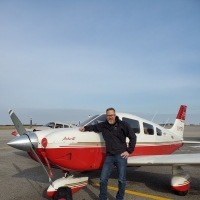Newbie with an Archer III. Need to nail down circuit/Pattern speeds...
Hello! So, I'm still a student and have acquired an Archer III...it's so close to the warrior I was training on, but I'd appreciate some input from experienced owners on the exact speeds to be following for this plane in the pattern. Ie...downwind, base, final....I've read 75 on final, and others say 66 on final...others say 75 on final, and 66 on short final...what is "short final",can't find an exact definition of that. Any advice would be appreciated. Thanks!


Comments
Now that's what I'm talkin' about, Greg! Nice bird you picked up! Short final, by the way, is the last 1/2 mile or so to touchdown on final approach.
Scott Sherer
Wright Brothers Master Pilot, FAA Commercial Pilot
A good rule of thumb is to take your final speed (75) and add 10 knots for the base and 10 more for the downwind. So 95/85/75 and then 66 over the numbers.
Jim M.
PA-28R-200
Based at BUU
ATC Chicago TRACON
And don't pull power completely until the main wheel are on the ground.
I love to defy gravity!
1979 Arrow IV
I always touch down with the throttle at full idle. Generally, it's a smooth landing. So you need power to arrest the descent a little? Hmmm. I have a turbo arrow 3 and maybe that's a little different than your arrow 2. Interesting.
Scott Sherer
Wright Brothers Master Pilot, FAA Commercial Pilot
I have been flying Archer IIs since the mid 80s. So, a couple of observations for you. First, having flown Warriors, Archers are a significant step up when you go from 160 to 180 hp. They are similar but not the same, the Warrior, for example, won't keep up with me on a long cross country. In a rectangular pattern, you should be able to fly the downwind at 90 kts or less depending on pattern congestion. Slowing on crosswind and again on final. For a standard one mile or so final 70kts is plenty. Short final should be reducing speed to 60kts. You should be in a position which permits you to pull the throttle to idle round out flare and run out of altitude and airspeed at the same time over the runway. If done correctly, this will be a nice no thump landing and the plane will roll to a stop on its own in a very short distance. Power should only be used to arrest an excessive descent rate. I suggest that you practice some slow flight (as a student do this first with your CFI) in the 50kts range. I love going up and "hanging" it on the prop while barely moving over the ground. Also a couple of suggestions on that beautiful plane in your pic. First, be sure to close the top latch if you are tied down outside, it helps the seal in the door should it decide to rain while you are gone. Second, when tied down keep your flaps retracted it helps protect them and doesn't provide any unnecessary lift for gusts. Finally, I recommend a gust lock which attaches to your throttle quadrant such as https://www.aircraftspruce.com/catalog/appages/atcontrollocks.php?gclid=Cj0KCQiAmZDxBRDIARIsABnkbYT2rPd0zJF9-X3wRQI1IKpFxI5JFWLUmYTkjpks63T-mwoc-2EzqpkaAmmbEALw_wcB rather than using the seat belt. Most of all I recommend that you have fun and be safe.
Great control lock. I bought one for an Archer III with "horns" on the control yoke. Once adjusted, the standard control lock would not go over the horns without readjusting each time. So, the company that makes the control lock (Airplane Things, Inc) modified the control lock with a clasp on the webbing. (Similar to the clasp on a canopy cover.) Now it easily installs and removes for each flight.
Older thread, but I'm just catching up here, so...
For an Archer II, I've always used 90/80/70 for Downwind/Base/Final, and reduce to about 65 as Jmcmanna pointed out above. For power management, while reducing for landing I like to go almost to idle, but not quite all the way. Generally, it's not great to carry power in as it risks float. (Unless you're doing this intentionally for some reasons like managing gusts of whatever.) So why leave just a tad of power in? Once in another aircraft I had an engine quit during roll out. Something had happened to the idle adjustment. Since then, I don't like the throttle completely closed on landing. I'm only talking about tiny bit more RPM here, but I just like to not put the throttle all the way to the stop or all the way out, (depending on throttle type). If I'm at a really short field and I truly want zero extra power at all, I will pull it all the way out once I'm sure runway is made.